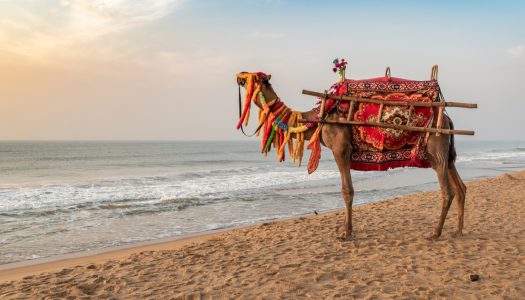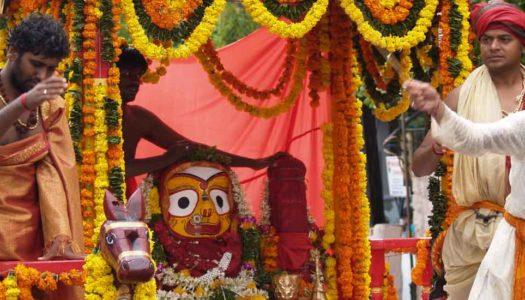Jagannath temple is a renowned Hindu pilgrimage site that is known for its impeccable architecture and admirable Niraakara (shapeless) deities. Though shrouded in mystery, this temple receives lakhs of devotees from across the world.
Here’s everything you need to know about Jagannath Puri, the temple where the heart of the Lord rests.
Also Read: Top 9 Tourist Places to Visit in Bhubaneshwar and No.9 Will Surely Blow Your Mind
History of the Temple
The Jagannath temple’s history dates back thousands of years. Though there are different stories associated with the temple, the most widely accepted history is that of King Indradyumna.
When Lord Shri Krishna resided in Dwarka, he was resting in a dense forest near Veraval, on the western coast of Gujarat. A hunter named Jara, mistook the leg of Shri Krishna to be a deer and hit it with an arrow. Because of the fatal injury, Lord Krishna took his last breath and told Jara that his journey on Earth had finally come to an end. Jara was devastated and felt guilty for his recklessness. The only thing he could do was properly cremate Lord Krishna respectfully.

After Jara burned Shri Krishna’s human body, a small shiny metal piece was left in the ashes. It wouldn’t burn, Jara couldn’t sell it to anyone and didn’t understand the object. Ultimately, he set it on top of a wooden plank and let it go in a flowing river.
King Indradyumna was a devotee of Shri Krishna. The Lord appeared in his dream and instructed him to take a bath in the river where the metal piece was left. King Indrayumna came across the mystery object and brought it back to the palace. Narada Muni asked the king to make idols of three deities – Lord Krishna, his brother Balarama, and sister Subhadra to instil in the greatest temple of all times – The Jagannath Temple.
No one was able to do it until Lord Vishnu himself disguised himself as an architect and agreed to make the idols. But, under one condition – ‘I will take 21 days to make the idols and no one should disturb me’.
However, the Queen, King Indradyumna’s wife grew agitated after two weeks when no noise came from the architect’s room. They opened the doors and found no one, except for the three idols made of wood that were incomplete. They didn’t have any hands. However, the king heard a divine voice instructing him to take these idols to the temple and that Lord Krishna’s heart rests in the wooden marvel!
Today, it is said that Lord Krishna’s heart or the mysterious metal object is still within the idol and emits high electrical energy. Seeing how wood is a bad conductor, the idols can endure the radiation. However, the main priests change the idols every 12 years because the material starts to deplete and wear out because of this radiating energy.
Deities in Jagannath Temple in Puri

In the Jagannath temple, you will see three deities – Lord Krishna, his brother Balarama, and his sister Subhadra. They are all made of neem wood, ‘daru’. You will also find smaller carvings of the Sudharshana chakra – an ethereal discus, Madanmohan idol – a form of Lord Krishna, Sridevi idol – Lord Vishnu’s wife, and Viswadhatri idol – Goddess of earth. The main three deities are all placed on a platform called the ‘Ratnabedi’.
The idols are painted beautifully, and covered in regal clothing and jewels. The deities were worshipped even before the contemporary Jagannath temple was built. You will notice that the eyes of Lord Krishna are wide and bright while that of Balarama and Subhadra look like normal human eyes. It is said that the Lord’s eyes are wide to look at all his devotees. This form of the Jagannath is called ‘Chakadola’ or the one with big eyes.
There is also a very sweet story about this form of Lord Jagannath. Once, Subhadra and Balarama’s mother, Rohini, was narrating the mischievous yet very charming antics of Lord Krishna to the queens of Dwarka and other residents of Vrindavan. Subhadra was made to stand guard because these stories were confidential. Noticing Subhadra standing out, Balarama and Krishna came to stand on either side of her.
Listening to what his aunt was telling about him, Lord Krishna’s eyes widened while that of Subhadra’s and Balarama’s twinkled with fascination. That is exactly what you’ll see in the Jagannath temple.
Temple Architecture
The Jagannath temple is built in the Kalinga architecture style that is very famous in India, especially in Odisha. The temple is spread across a vast area of 37,000 square metres. The main sanctum sanctorum has the idols and has a curvilinear structure. The main dome of the temple has a pyramidal structure and has the Neelachakra at the top. This is an ethereal wheel with eight spikes made from a mixture of eight alloys. Surprisingly, no matter from which spot you look at the wheel, it will always face you. There is also a flag adjacent to the wheel that always flies in the opposite direction of the wind!
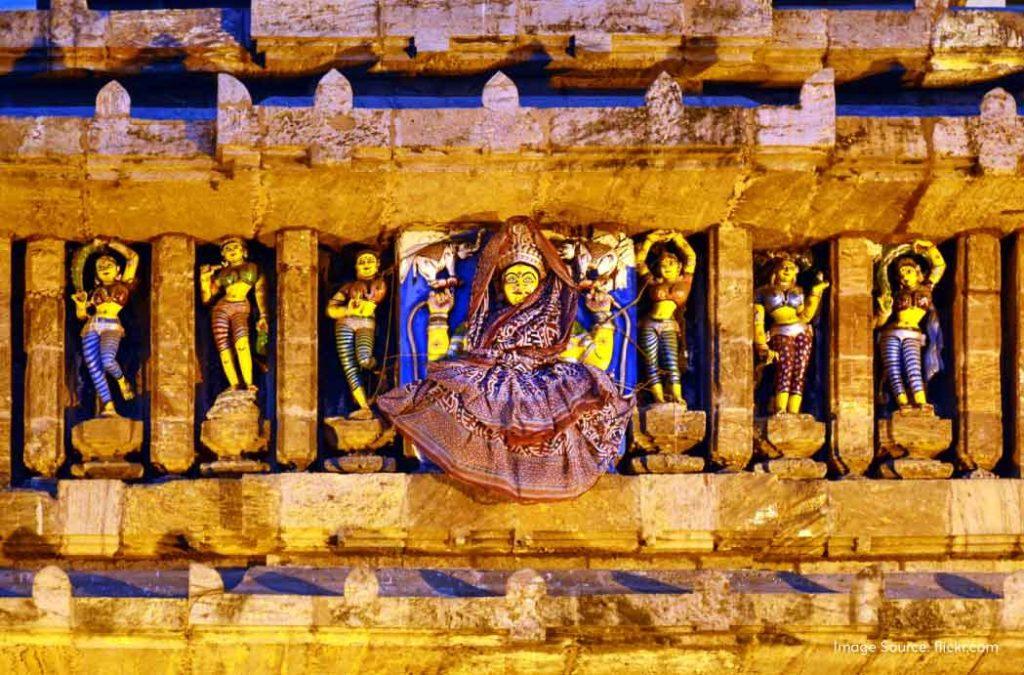
The inner temple complex consists of 120 temples and shrines. Apart from the main sanctum sanctorum or Garbhagriha, you can also see the Mukhashala – front porch, Natamandapa – dancing hall, Bhogamandapa – offering hall.
The temple is built on a stone platform and reaches up to a height of 210 feet. The inner complex is surrounded by a wall called the kurma bedha. The entire temple complex is surrounded by an outer wall called Meghanada Pacheri which is 20 feet in height. The Jagannath temple is the tallest temple in Odisha and one of the tallest temples in the world!
Entry Timings and Darshan Tickets
The general entry into the Jagannath temple is free of cost. But on certain occasions or festival days, the temple authorities collect INR 10 per person for darshan. The special darshan lets you seek blessings from Lord Jagannath behind closed doors in peace and tranquillity. This ticket costs INR 100 per person.
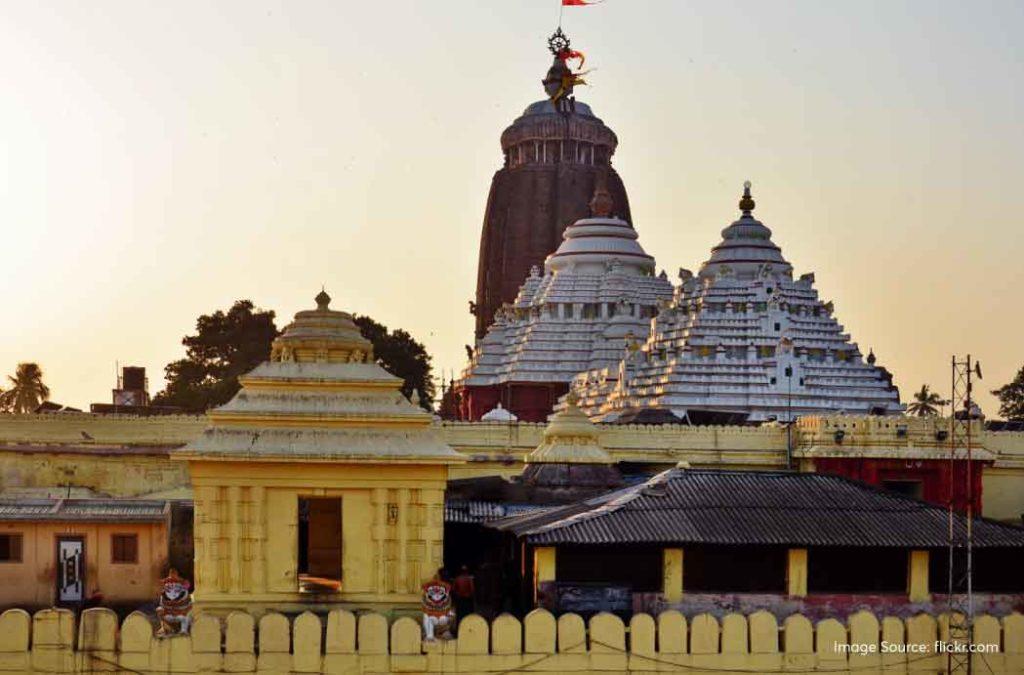
However, it is important to note that any non-Hindus are not allowed inside the main sanctum sanctorum of the Jagannath temple. Even foreigners, Sikhs, and Buddhists are not allowed to see the deities. In the past, several foreign delegates and tourists were asked to seek blessings from outside the Jagannath temple and not enter the main Garbagriha. This is a topic of controversy but the tradition has been running strongly ever since the temple was built.
Daily Food Offerings to the Deities
The deities are offered food or prasad six times a day in the Jagannath temple.
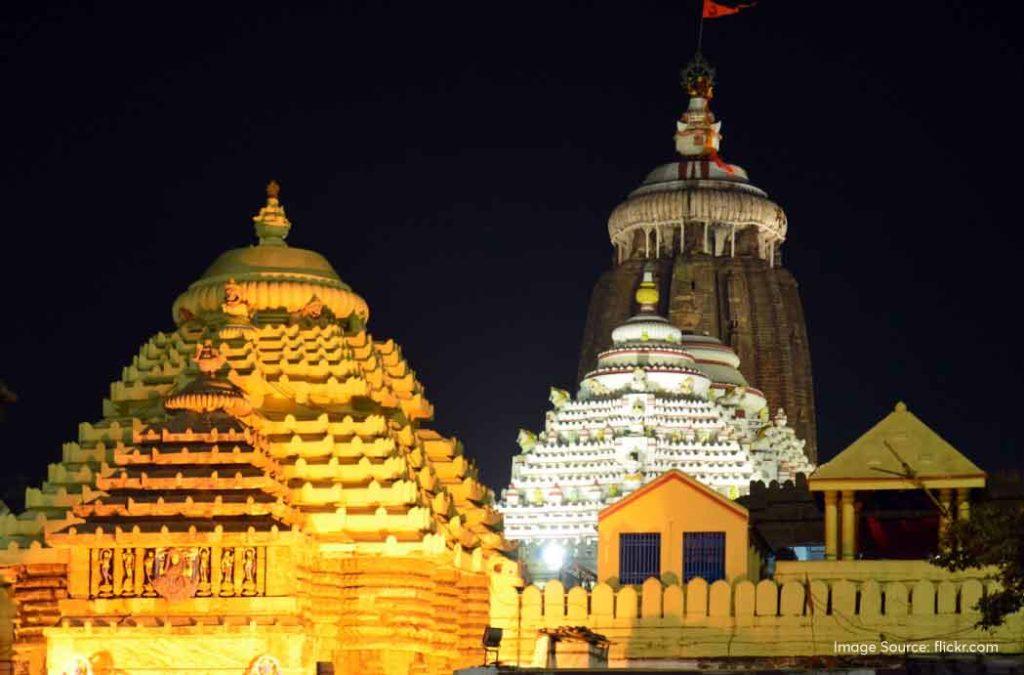
Offering 1: Gopala Vallabha Bhoga – The first meal of the day or breakfast at 4:00 AM that has 7 items including popcorn sweetened with sugar, a favourite of Lord Vishnu, ripe bananas, coconut gratings with jaggery, and khoa (dried whole milk).
Offering 2: Sakala Dhupa – This is offered around 10 AM and includes Haldi Patra Pitha (made of turmeric, black gram, and coconut) and Mantha Puli (made of rice flour and urad dal) among 13 other items.
Offering 3: Bada Sankhudi Dhupa – This offering is made around 1:00 PM and includes fermented rice or Pakhala with curd, and Kanji (brew with vegetables) pyas. This food is also given to the devotees in the Bhogamandapa.
Offering 4: Madhyana Dhupa – This is offered before 3:00 PM and is the main meal of the Lord in the afternoon. A variety of sweets, desserts, and snacks are offered.
Offering 5: Sandhya Dhupa – This is offered at 8:00 PM and includes snacks, sweets, and rice preparations.
Offering 6: Bada Singhara Dhupa – This is the last meal for the day and will be served at 11:15 PM. It includes simple recipes made with different types of dal, rose petals, and rice.
The kitchen where the offerings for Lord Jagannath are cooked is the second biggest in the country. It is said that Goddess Lakshmi, the wife of Lord Vishnu, supervises the cooking and if she is displeased, a shadow of a dog appears at the entry door. If the cooks and priests notice the shadow, the food is immediately recooked. All recipes here are devoid of onions and garlic and completely vegetarian.
It is said that the Puri Jagannath temple never falls short of Prasad because the Lord makes sure that every devotee returns home with a filled stomach.
Why Is Puri Jagannath Temple so important to Hindus?
The Puri Jagannath temple is one of the Char Dhams that hold great significance in Hinduism. The Puri Jagannath temple in the east, Badrinath in the north, Dwarkadeesh temple in the west, and Ramanathaswamy temple in the south. It is said that these pilgrimage sites are situated in the four corners of the country and visiting them at least once in a lifetime can help devotees seek salvation. The journey usually begins at the Jagannath temple in the east and moves in the clockwise direction. This is very similar to the circumambulations that Hindus do in temples.
You Can Read More About the Char Dhams Here: Experience the Pilgrimage of a Lifetime on This Char Dham Yatra!
The Rath Yatra of Puri Jagannath Temple
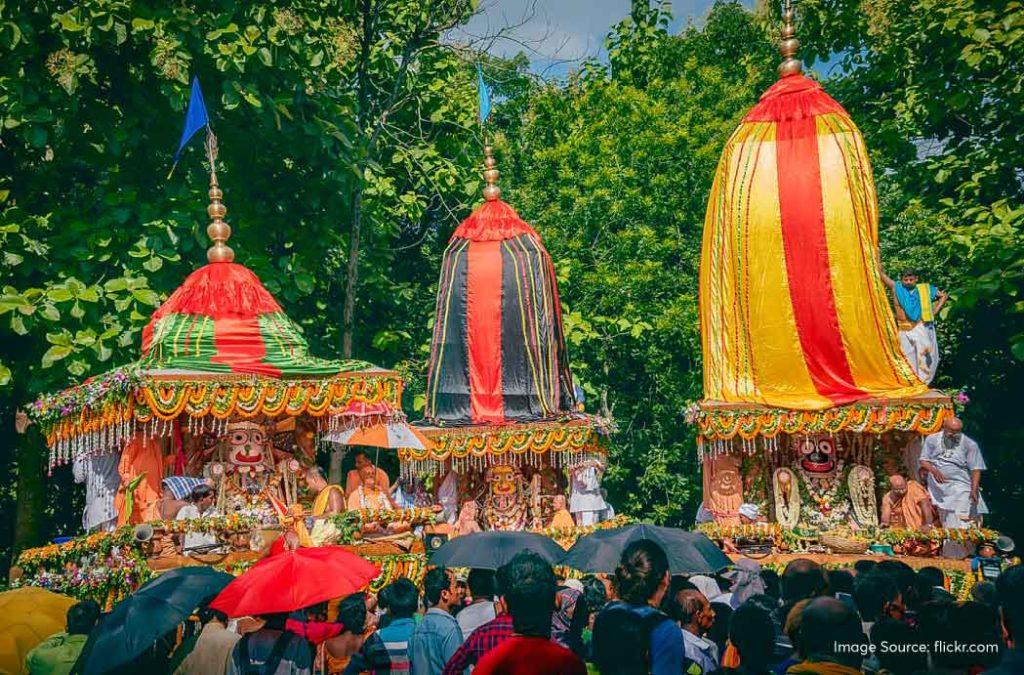
The Rath Yatra or the Rath Jatra is one of the biggest chariot festivals in the country. This annual celebration brings the devotees closer to Lord Jagannath and is also mentioned in the Brahma Purana, Skandha Purana, Padma Purana, and Kapila Purana. It happens on the second day of the Ashada month in the lunar calendar, usually in June and July.
Lord Jagannath, Lord Balarama, and Goddess Subhadra are brought out of their shrine and taken on a rath yatra or chariot ride. It is a week-long event when Lord Jagannath sees his devotees in person and people come to look at his glorious form.
The chariots are made of wood taken from traditional trees like phassi and dhausa. The carpenters who make the chariots have been doing so for generations and believe it to be their birthright to serve the Lord.
The deities along with the Sudarshan chakra leave the Jagannath temple and move to the Gundicha temple. They stay here for a week before returning to their home – Jagannath Puri. On their way back, they stop by the Maa Mausi temple (aunt’s abode), and are served Poda Pitha (a type of pancake made of rice flour). It is as if they’ve set out on a journey, stopped to greet their aunt, and ultimately return to their home.
A lot of people, usually in lakhs, gather to seek blessings from Lord Jagannath. It is believed that attending the rath yatra, talking about it, or even knowing about it can open doors to heaven.
How to Reach Puri?
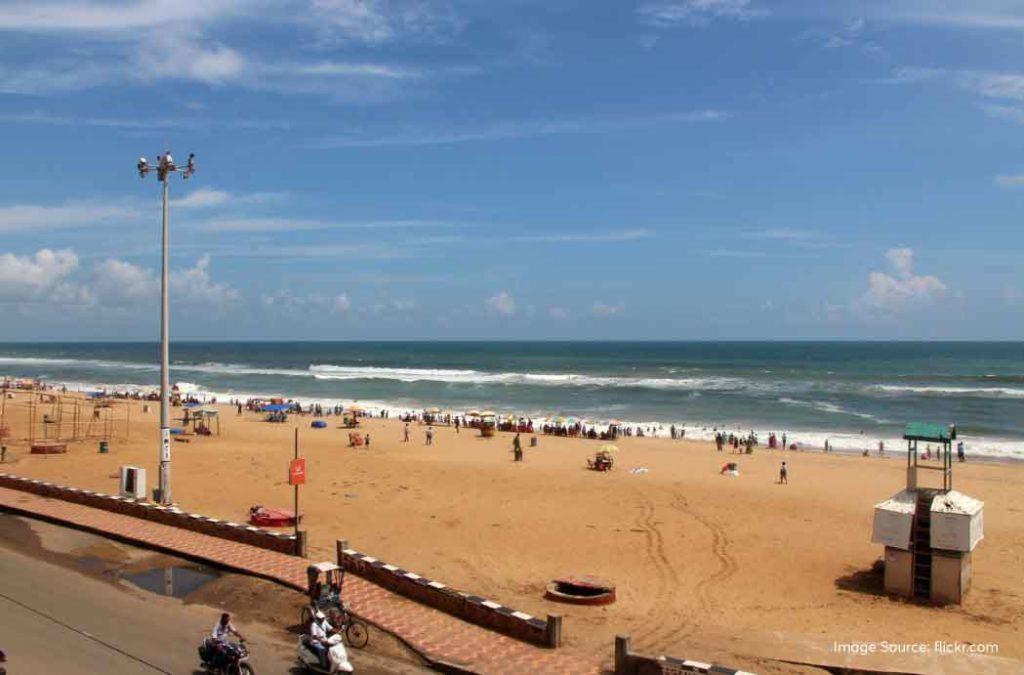
Puri is well connected with the rest of the metropolitan cities in India. You can either board a flight, take a train, or use the well-developed road transport routes to reach Jagannath Temple Puri.
While you are here, book your stay at Hotels in Puri, relax for a while after the journey, wear fresh clothes, and go to the temple for darshan.
By Air
Bhubaneshwar is the capital city of Odisha and is only 56km from Puri. You can take a flight from any of the other Indian cities like Delhi, Mumbai, Jaipur, Kolkata, Hyderabad, Chennai, and Bangalore to reach Biju Patnaik Airport in Bhubaneshwar. International travellers must reach Delhi, Kolkata, Mumbai, or Hyderabad first and then head toward Bhubaneshwar.
By Rail
The Puri Railway Station receives regular trains from Delhi, Chennai, and Kolkata. You also have trains that run between Bhubaneshwar and Puri. The Jagannath temple is roughly 3 km away from the railway junction.
By Road
Buses run regularly between Bhubaneshwar and the Gundicha temple bus station in Puri. The distance can be covered in 15-20 minutes. NH16 connects southern cities like Hyderabad, Chennai, and Bangalore with Bhubaneshwar. People coming from the south can reach here first and head toward Puri.
Plan your trip to Jagannath temple soon and indulge in the peaceful hymns and positive chants of the ‘Lord of the Universe’.








